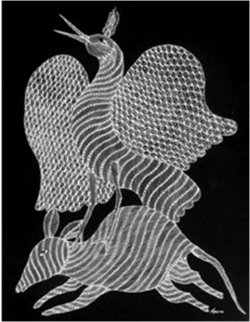Gonds Art - Madhya Pradesh
The Gondi (G?ndi) or Gond people are people spread over the states of Madhya Pradesh,
Maharashtra, Chhattisgarh, Andhra Pradesh, and Orissa.Population: With over four
million people, they are the largest tribe in Central India. Gond is the largest
tribe in India.

About the language and meaning of gond
-
Gond word has come from Telugu word 'Kond' which means a mountain. It seems that
after the down fall of their rulers(king)they took shelter in the mountains and
started living there. They started calling them 'Konda dorul‘. Konda means
mountain and dorul means Master. Gonds call them 'Koitoor'. Koitoor it self means
man. Likewise 'Korku' means a group of men in their language.
-
Gonds believe in the supernatural forces(like superman n all). Their protectors
are the gods and goddesses who keep them from harm. Their songs, dance forms,
folk tales, customs and ceremonies reflect a close bond with nature and all
are inter-related.
History of Wall Painting in India
The oldest wall paintings in India are found in the caves of Bhimbetka one of the
World Heritage Sites [WHSs] declared by United Nations Educational Scientific and
Cultural.
Raw Materials
Tribal painting is done mainly on the mud walls of the houses in the villages. The
raw material requirement is different.
Wall Painting:
Soil: A special soil called PIDOR is used for preparing the surface
of the wall for the painting.
Natural colours: Various natural materials are used for providing
different colours to the drawings.
For example -> wooden coal for the colour black,
Chui soil for white,
Red soil or Geru for red,
The sap of the Tinsak plant for dark red,
Ramraj soil for yellow,
Sem leaves for dark green and cow dung for light green.

Canvas / Chart Paintings – Raw
Materials
Canvas/Chart paper:
The canvas is purchased from the local dealers.
The chart paper is also easily available in the local stationery shops.
Primer:
Fevicol and plastic emulsions are coated on the canvas as a primer.
Paints:
Acrylic paints used for painting fabric are used.
Wooden Frame
The few tools that are used in tribal paintings are as follows:
Wall paintings:
For wall paintings the locally made brush [called koochi in the local parlance]
is used.
This brush is made with the fibers obtained by crushing the bark of some locally
available trees.
Canvas/Chart paper paintings:
The main tool is a wooden frame on which the canvas/chart paper is fixed with the
help of drawing pins to straighten it.
Fevicol and plastic emulsions are used as primers on the canvas.
Preparing the Canvas
In the case of wall paintings —
Plasters the area of the wall to be painted with a paste of soil, cow dung and straw.
After it dries, the area is coated with a white soil called PIDOR applied which
provides a smooth, white background.
In the case of canvas paintings —
Cut the canvas into the desired size, stretched over a wooden frame using
drawing pins to straighten it, a coat of Fevicol is applied on the canvas followed by
one to three coats of plastic emulsion to provide a smooth surface. Then it
is left to dry. While the acrylic?painted drawings are multi-coloured, those made
by using the drawing pens are simple black?and?white sketches.
Different colours are used to paint different objects like trees, animals, etc.
Some colours have specific associations with emotions, for example:
religious thoughts - orange,
fear - red,
association with nature - green and so on.
Why now a days we are choosing charts for painting?
Charts are also painted in a similar way. They are easy to draw on because minimum
effort is required to prepare them as well as to store and transport them. The main
problem with charts is the lack of a finishing shine which is ample in case of the
canvas.